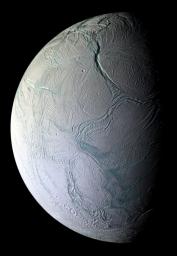
|
A Tectonic Feast
- Click the image above for a larger view
- Full-Res JPEG (1972 x 2848) (588.3 kB)
- Full-Res TIFF (1972 x 2848) (16.9 MB)
Caption:
On Oct. 9, 2008, just after coming within 25 kilometers (15.6 miles) of the surface of Enceladus, NASA's Cassini captured this stunning mosaic as the spacecraft sped away from this geologically active moon of Saturn.
Craters and cratered terrains are rare in this view of the southern region of the moon's Saturn-facing hemisphere. Instead, the surface is replete with fractures, folds, and ridges—all hallmarks of remarkable tectonic activity for a relatively small world. In this enhanced-color view, regions that appear blue-green are thought to be coated with larger grains than those that appear white or gray.
Portions of the tiger stripe fractures, or sulci, are visible along the terminator at lower right, surrounded by a circumpolar belt of mountains. The icy moon's famed jets emanate from at least eight distinct source regions, which lie on or near the tiger stripes. However, in this view, the most prominent feature is Labtayt Sulci, the approximately one-kilometer (0.6 miles) deep northward-trending chasm located just above the center of the mosaic.
Near the top, the conspicuous ridges are Ebony and Cufa Dorsae. This false-color mosaic was created from 28 images obtained at seven footprints, or pointing positions, by Cassini's narrow-angle camera. At each footprint, four images using filters sensitive to ultraviolet, visible and infrared light (spanning wavelengths from 338 to 930 nanometers) were combined to create the individual frames. The mosaic is an orthographic projection centered at 64.49 degrees south latitude, 283.87 west longitude, and it has an image scale of 196 kilometers (122.5 miles) per pixel. The original images ranged in resolution from 180 meters (594 feet) to 288 meters (950 feet) per pixel and were acquired at distances ranging from 30,000 to 48,000 kilometers (18,750 to 30,000 miles) as the spacecraft receded from Enceladus. The view was acquired at a Sun-Enceladus-spacecraft, or phase, angle of 73 degrees.
Background Info:
The Cassini-Huygens mission is a cooperative project of NASA, the European Space Agency and the Italian Space Agency. The Jet Propulsion Laboratory, a division of the California Institute of Technology in Pasadena, manages the mission for NASA's Science Mission Directorate, Washington, D.C. The Cassini orbiter and its two onboard cameras were designed, developed and assembled at JPL. The imaging operations center is based at the Space Science Institute in Boulder, Colo.
The Cassini-Huygens mission is a cooperative project of NASA, the European Space Agency and the Italian Space Agency. The Jet Propulsion Laboratory, a division of the California Institute of Technology in Pasadena, manages the mission for NASA's Science Mission Directorate, Washington, D.C. The Cassini orbiter and its two onboard cameras were designed, developed and assembled at JPL. The imaging operations center is based at the Space Science Institute in Boulder, Colo.
For more information about the Cassini-Huygens mission visit http://saturn.jpl.nasa.gov/ . The Cassini imaging team homepage is at http://ciclops.org .
Cataloging Keywords:
| Name | Value | Additional Values |
|---|---|---|
| Target | Enceladus | Saturn |
| System | Saturn | |
| Target Type | Satellite | Planet |
| Mission | Cassini-Huygens | |
| Instrument Host | Cassini Orbiter | |
| Host Type | Orbiter | |
| Instrument | Imaging Science Subsystem (ISS) | |
| Detector | Narrow Angle Camera | |
| Extra Keywords | Color, Crater, Infrared, Mountain, Ultraviolet, Visual | |
| Acquisition Date | ||
| Release Date | 2008-12-15 | |
| Date in Caption | 2008-10-09 | |
| Image Credit | NASA/JPL/Space Science Institute | |
| Source | photojournal.jpl.nasa.gov/catalog/PIA11133 | |
| Identifier | PIA11133 | |
